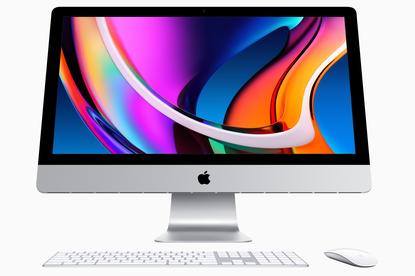The new Intel iMac is a sensible buy despite incoming Apple ARM Macs
- 25 August, 2020 10:00

Apple is rightly criticised for its stagnant Mac design. The MacBook Air lingered in its silver wedge form with no Retina display for far too long, and the same fate appears to have befallen the beloved iMac.
that I have been testing looks pretty much identical to the 2012 iMac released the year the body of the computer became slim and tapered. But that design was based off the 2009 unibody iMac, which itself was an iteration on the first aluminium iMac from 2007. It isn’t a stretch to say the 2020 iMac’s design is a riff on a 13-year-old iMac.
But perhaps the criticisms are born from our iPhone-oriented brains. When the iPhone doesn’t change for a year or two there are grumbles from the tech community. No one will know we’ve upgraded if it looks like last year’s! Thankfully this reason not to upgrade is stopping some people needlessly replacing their phone every year.
With an iMac, how much can you really change? OK, in 2020 the iMac’s bezels are too large but remember there’s no tower here, the display contains the computer. It’s the guts of the thing behind the untouched design that are coming under more scrutiny this year given the machine is the beginning of the end for Intel chips in Macs.
The 2020 iMac is the first Mac released since Apple announced it would release its first Mac with its own in-house chip before the end of the year. We still don’t know if it’ll be an iMac, MacBook, or Mac mini, but the excitement is palpable because the Mac hardware will finally be fully controlled by Apple like it is on the iPad and iPhone.
The hope is that Apple can streamline the Mac’s performance, but a lot of the excitement is for the effect that will have on MacBooks. Better performance and battery life in particular are the goals for Apple’s portable Macs, and that will be exciting to see.
That still puts this new Intel Mac in the cross hairs. What if Apple releases an iMac soon with its own chip? Won’t that render the 2020 Intel iMac redundant? Well, no, it won’t.
Apple first used Intel chips in its iMacs back in 2006, so this computer is part of the closing chapter of a 14 year evolution. It means it is a ridiculously well-oiled machine, chewing through everything that I’ve thrown at it for the past two weeks with nothing so much as a bead of silicon sweat to show for it.
The model Apple sent me to test is the highest spec of the three configurations you can get before you start upgrading at point of purchase. That means it’ll set you back a cool AU$3,549 while the base model starts at AU$2,799. My loaner has a 3.8GHz 8-core 10th-gen Intel Core i7 paired with 8GB RAM and 512GB SSD, topped off with a Radeon Pro 5500 XT with its own 8GB of GDDR6 memory.
The extra spend over the lower two tiers gets you the i7 instead of i5 and the upgrade in graphics, basically. You can also spend an extra AU$750 if you buy online to get a new nano-texture glass that gives the display a slight matte effect and much less glare. Unfortunately my review unit doesn’t have that coating so I can’t speak to its effectiveness.
In use the iMac feels exactly what you’d hope for and expect from such an expensive desktop – completely capable and utterly well-tuned. It doesn’t crawl to a halt when I’m caning Chrome with a disgusting number of tabs with Photoshop, Spotify, Slack, Word, and Todoist all running. Not a spinning beach ball in sight.
And while I can’t go as far as to praise Apple for finally adding a 1080p webcam to a $3,000 computer, it is a marked improvement and a welcome one given the number of video calls I now find myself on. The speakers too, while always good on an iMac, are even better here with excellent depth. I definitely don’t personally push my computers as much as a professional might with Final Cut fired up, but my experience with this iMac has been extremely positive.
Sometimes iteration is bad. In this case, I feel that it is sensible for those who need to upgrade safe in the knowledge that ‘it just works’.
Such excellent performance is not guaranteed for Apple’s first generation Macs with its own ARM-powered chips. It’s too early to speculate and obviously I hope that Apple nails it first time. But given the pitfalls of many first-gen tech products I’d wager that if you’re in the market for a new iMac right now then you probably want to get this latest Intel one. Sure, it might look a lot like your old iMac but you’ve probably had that iMac for the best part of five years, maybe more.
I can say with certainty that the 2020 iMac will last you that long no question, whereas holding out for an Apple-powered iMac might be an expensive step into the unknown. Intel might be parting ties with Apple, but at least its swansong is this good.





